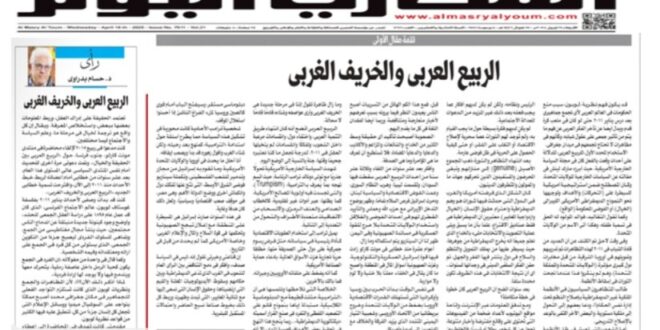The Arab Spring and the Western Autumn
By Dr. Hossam Badrawi
Truth depends on the mind’s perception, connecting pieces of information, and extracting knowledge. It is said that every reality was once an imagination, and political science and sociology are no different.
In the spring of 2015, I was invited to deliver a lecture at the Monte Carlo Forum in southern France titled “The Arab Spring: Between Reality and Imagination.” I was invited again this year to speak before the same high-level political forum, ten years after my first speech, to trace the thread of events from 2011 until now. I proposed the new title: “The Arab Spring and the Western Autumn.”
Back in 2011, I described the events of January through the lens of Gustave Le Bon, the French sociologist who, in 1895, studied the collective mind of crowds. He explained the emergence of a new entity that arises when people gather, creating a magnetic field of collective identity that overrides individual opinions, beliefs, and values.
As he said in one of his quotes:
“An individual in a crowd is like a grain of sand caught in a sandstorm, moving and merging with it, stripped of individual will.”
Why do I mention this now? Because what Le Bon’s theories once required—a physical crowd gathered in one place—is now made possible through social media and media platforms, where every person becomes part of a larger whole, subject to the same principles of crowd psychology.
In my lecture, this introduction was intended to offer a scientific foundation to help us understand what happened—and is still happening—in the Arab world.
Perhaps understanding Le Bon’s theory is why Arab governments banned any large public gatherings after the lesson of January 2011, even in football stadiums. It also reflects how the Arab world has fallen behind in grasping the collective influence on the minds of its youth, who can now participate in virtual protests without ever gathering in a physical square.
The first clear use of the term “Arab Spring” was in Foreign Policy magazine, where Mark Lynch highlighted it in a piece about U.S. foreign policy. The phrase was part of an American strategy to control the movements and guide them toward either the liberal democratic model (imagination) or controlled chaos (reality).
As tradition goes, the father of a newborn has the right to name the child—thus, the name came from the United States.
Later, it was revealed that many of the young leaders of the 2011 protests were trained and funded in Eastern Europe by the intelligence agencies of major powers (namely, the U.S. and the U.K.). These countries did not deny this involvement when the revolutions succeeded in toppling regimes.
The protestors in monarchies demanded reform under the same rulers—some called for a constitutional monarchy, others accepted gradual promises of reform.
But in republics like Egypt and Tunisia, people demanded the removal of the president and his regime—yet they had no clear ideas about what should happen afterward, other than general calls for social justice.
They had no simple plan for what to do next. The revolutions did not magically fix the economy, overcome poverty, or even define how freedom could be achieved amid overwhelming chaos.
After the protests ended, the genuine crowd went home, leaving behind the instigators and opportunists—those driven by intelligence agencies, financial backers, and religious extremists.
What the U.S. and the West imposed on the revolutionized countries was an illusion of democracy and respect for human rights—an example of imagination and double standards. They viewed democracy only as ballot boxes, ignoring the fact that everything before and after elections is rife with manipulation—where funding, organization, and arms decide the outcome in nations plagued by poverty and ignorance, where Salafi thought had been deeply ingrained for years.
So, in such conditions, election outcomes were pre-determined.
Years later, it has become clear that the Arab Spring was a step in a larger plan.
With the rise of online information and countless YouTube videos presenting supposed events and varied news, everyone can become a hero—or a villain. The lines between illusion and reality are blurrier than ever. With overwhelming leaks and conflicting narratives, people began questioning what they see, even losing trust in everything presented to them.
The real difficulty now is confirming any truth amid deception, rumors, claims, lies, propaganda, and counter-propaganda. You can’t tell what’s a conspiracy and what’s coincidence.
Now, after ten years since my first Monte Carlo speech, and thirteen years after the Arab Spring:
- Sudan has fallen.
- Libya has fragmented.
- The Syrian regime fled.
- Lebanon is in economic and political collapse.
- Israel has utterly destroyed the prospects for peace.
- Iranian influence with Hezbollah and Hamas has become clearer, supported by Qatar.
- The U.S. no longer hides its use of military power to support Zionism.
- And the war in Yemen continues.
The scenario is ongoing.
Ten years on, Israel’s military and technological power has increased. Egypt is drowning in domestic and foreign debt. Zionism has infiltrated Gulf financial markets. What was once whispered in secret is now spoken aloud—without shame, blame, or evasion.
Meanwhile, the war between Russia and Ukraine is draining Europe’s economy under U.S. pressure. The UK has exited the EU. The far-right is gaining popularity, escalating division and tension with immigrants in both Europe and America.
The election of Trump, his fall, and his potential re-election reflect a new phase: the Western Autumn. I see its storms and winter approaching—inevitably.
The Arab Spring, in the end, marked the end of Arab development, the disappearance of countries, horrifying internal divisions, and a fragmentation beyond what anyone could have imagined in 2011. What we once saw as “hell” now seems like paradise compared to today.
U.S. foreign policy underwent a major shift under Donald Trump, embracing a new approach known as Trumpism, which prioritized “America First” through unorthodox tools: confrontational rhetoric, symbolic violence, withdrawal from multilateral agreements, and a shift from multilateralism to bilateralism.
Trump relied heavily on economic sanctions, even against friendly nations, launching a trade war that shook global markets under the pretense of protecting American industry.
He also pressured U.S. allies, both in Europe and neighboring countries—so imagine how he treated the rest.
The bottom line is that Trumpism marked a break from traditional diplomacy, replacing it with a model based on verbal escalation and decision-making monopoly. I called it “the dictatorship of democracy.”
While it might achieve short-term goals, it damaged America’s reputation as a stable diplomatic partner, opening the door for powers like China and Russia to fill the vacuum—if they play their cards right.
Trump’s unilateral personality was central to this policy, raising questions about the sustainability of Trumpism as an approach beyond his presidency.
But the Western winter has begun. And the blossoms are fading.
As I prepare my speech thirteen years later, I ask myself:
How do we measure an event?
By its actions?
Its results?
Or its lasting impact?
As I analyze what’s happening in Europe and the U.S., Israel’s massacres and destruction of the Palestinian people, the continuation of the Middle East chaos plan—leading to the collapse of nations, shrinking of others, and putting the most important state, Egypt, in an economically and politically weak position—I wonder: Was this the intended goal all along?
Today, Israel controls the region, with arrogant Zionism dominating military power, financial influence, and Western—especially American—media like never before.
My conviction and experience tell me:
“There are no coincidences in politics.”
I reflect on the contradiction between public opinion in the West—which claims to uphold democracy—and their leaders, the fall of declared ideologies, the erosion of accepted values, and the collapse of human rights amidst blatant double standards.
All of this ties into the narrative I am crafting for this forum—connecting the threads of our present reality and the potential futures of humanity.
I welcome your comments and reflections.
 Dr. Hossam Badrawi Official Website
Dr. Hossam Badrawi Official Website


